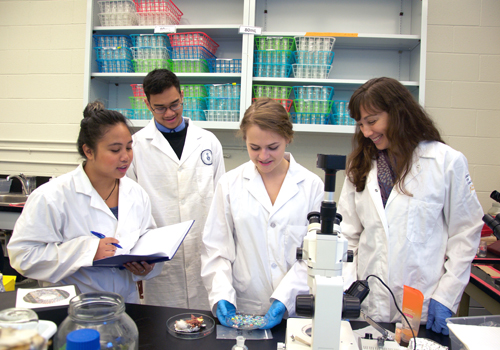For some Arts & Science undergraduate students, participating in the Research Opportunity Program (ROP) is a first chance to get “hands on” with the process of academic discovery, get some solid mentoring from established scholars and experience working on a research team.
For others, such as Joseph Moysiuk, it’s a major step toward what will hopefully be a lifelong career in research. It was a smart move and last month, Moysiuk had the rare distinction of being first author on a paper published in Nature, one of science’s most prestigious academic journals.
The Earth sciences and ecology & evolutionary biology student contributed to a project that decisively classified an extinct, 530-million-year-old group of animals for the first time. The work was co-authored by two U of T ecology & evolutionary biology alumni, Martin Smith and Jean-Bernard Caron. Caron, Moysiuk’s ROP supervisor, is associate professor in the Departments of Earth Sciences and Ecology & Evolutionary Biology.
“Even when I was in high school, I was aware of opportunities for undergraduates to do research here and this was a major draw for me to attend U of T,” Moysiuk said. “I’ve been interested in paleontology since I was very young. In my first year, I completed Victoria College’s Vic One program and had the opportunity to write a research grant proposal on a chosen topic, with mentorship from Professor Caron. I explored the evolution of a group of extinct arthropods. This project solidified my ambition to pursue graduate studies in paleontology.
“The Research Opportunity Program was an obvious next step.”
Students learn array of skills with guidance of experienced faculty members
On the way to earning a full degree credit with his ROP course, Moysiuk learned the nuances of interpreting fossils, how to operate a scanning electron microscope and interpret the output, as well as several new photography, microscopy and image editing skills. He was taught how to operate a small engraving tool to mechanically prepare fossil specimens. Most importantly, he learned how to write a primary research paper, from critically reading the scientific literature, to drafting and editing the manuscript, to the processes of submission and responding to peer review.
The project involved painstakingly scouring through hundreds of drawers in the collections of the Royal Ontario Museum in search of fossil specimens of a cone-shaped animal called a hyolith. The distinctive-looking shells of these marine creatures are common in the fossil record long before dinosaurs, but they had never been properly described and accounted for on the biological tree of life that illustrates the relationships between all living and extinct organisms.
A small number of specimens in the collection had exceptionally well-preserved aspects of soft-tissue anatomy never before observed in these animals. This led Moysiuk and his co-authors to conclude that hyoliths were not molluscs, as had often been hypothesized in the past, but were instead allied with brachiopods, a lesser-known group of animals that exist today.
“Altering the tree of life was not something I had set out to do,” he said. “While my goal had always been to contribute towards a peer-reviewed research paper, I never expected that I would be given the opportunity to lead a project of such significance as an undergraduate student.”
“I tip my hat to Joe for his exceptional work ethic, attention to details, and commitment to the research project through all its stages,” said Caron, who is also senior curator of invertebrate palaeontology at the Royal Ontario Museum. “Despite his young age, Joe shows great promise for research and I am hoping he applies to graduate school once he completes his undergraduate studies.”
Research projects span disciplines across Arts & Science
An average of 200 students participate in the Research Opportunity Program every year, assisting faculty members on a wide variety of projects spanning nearly all disciplines in the Faculty of Arts & Science. To name just a few:

- psychology students helped design tests to look for early signs of Alzheimer’s disease;
- urban studies students analyzed community input into the redevelopment of Toronto’s Regent Park neighbourhood to improve urban planning processes;
- computer science students developed video games and computer applications to help improve the cognitive abilities of senior citizens;
- history students helped reframe the 16th-century Reformation as more than a Protestant-Catholic affair;
- a chemistry student developed a series of recommendations to reduce waste in science laboratories across the U of T campus.
“The Research Opportunity Program gives second-year students a way to genuinely contribute to the research life of the University,” said Pamela Klassen, vice-dean of undergraduate education in the Faculty of Arts & Science. “While not all of them publish in a prestigious journal like Nature, many students say the experience is transformative for them. And their professors often say the same. We will continue to grow the program, launching it for third-year students as well next year, to provide opportunities for as many students as possible.”
Students wishing to enroll in the Research Opportunity Program for the 2017 summer term or the 2017-18 school year are encouraged to review the current course offerings and eligibility requirements on the program’s website, and submit an application by the March 6, 2017 deadline. All Arts & Science degree students who have completed no less than four credits, but no more than fourteen, by September 2017 are eligible to apply to the program.

